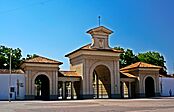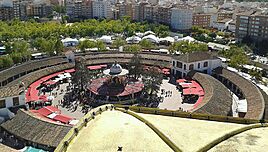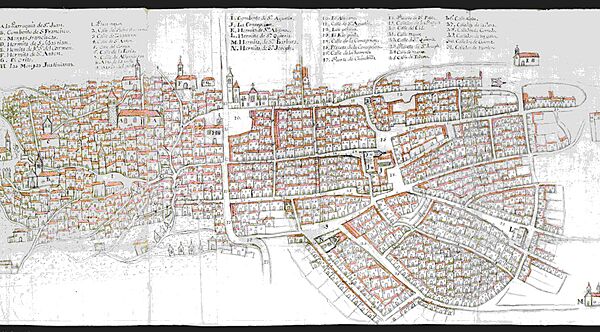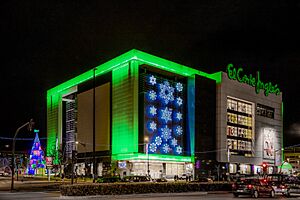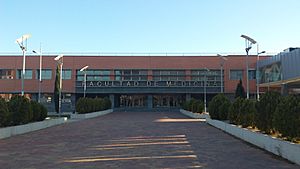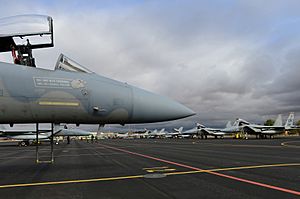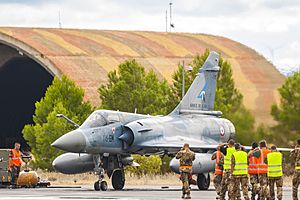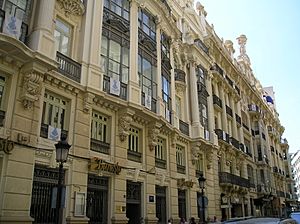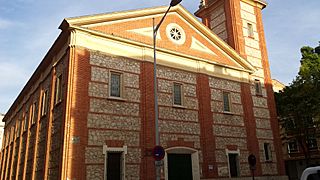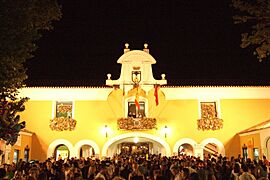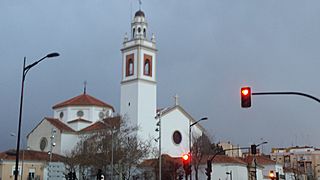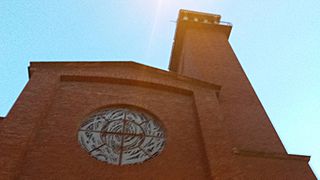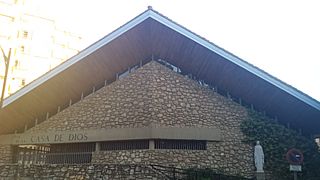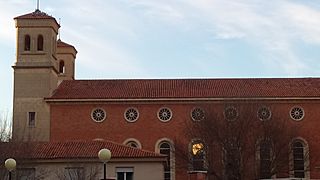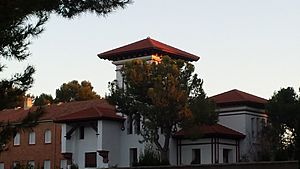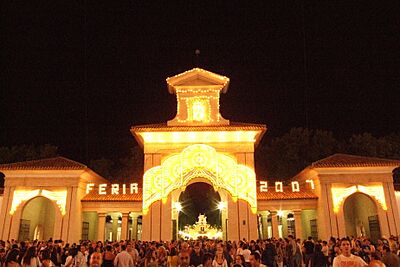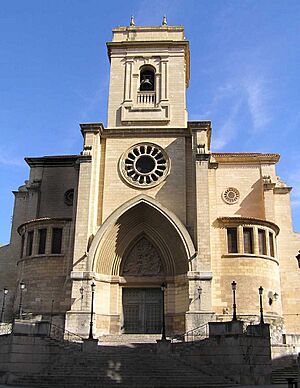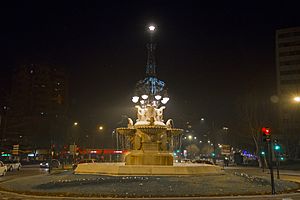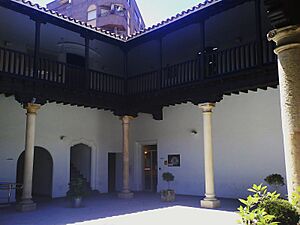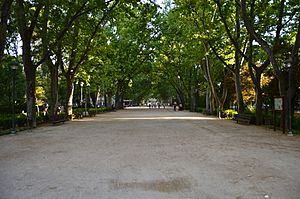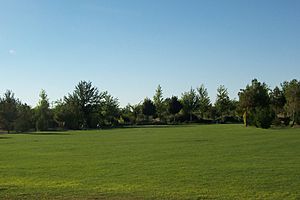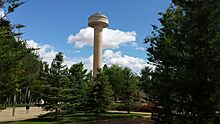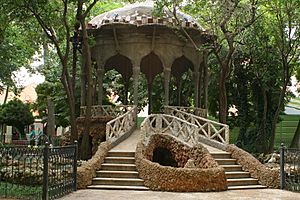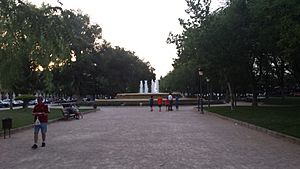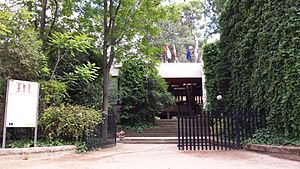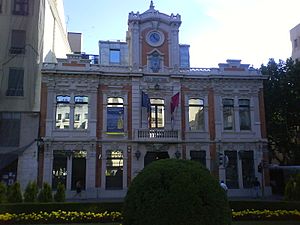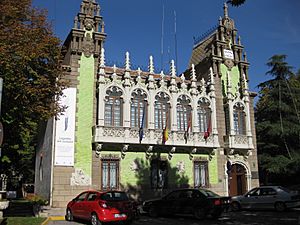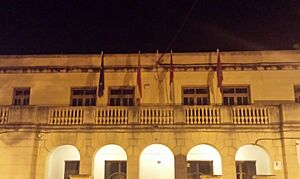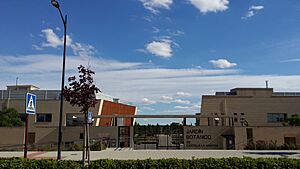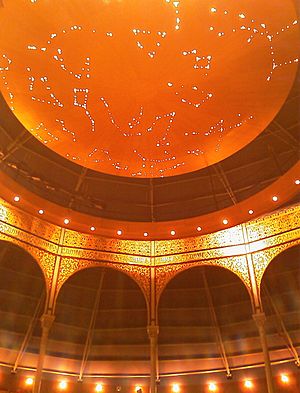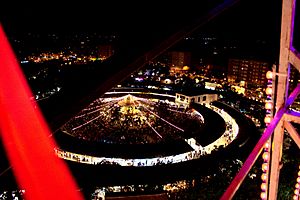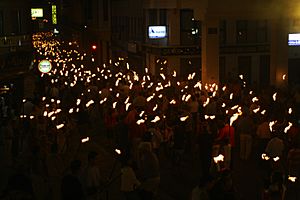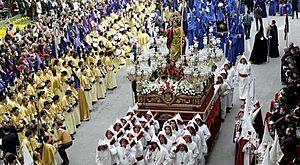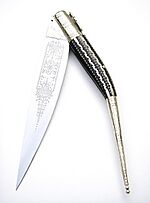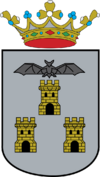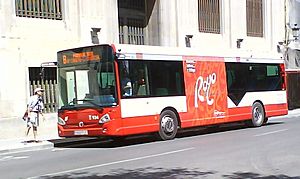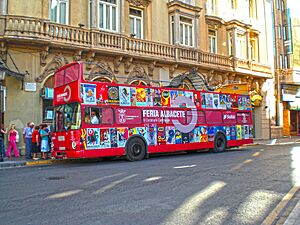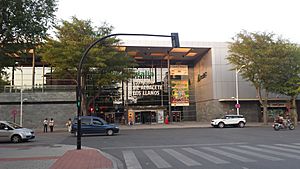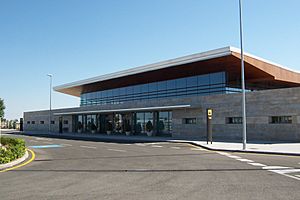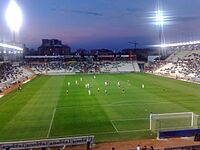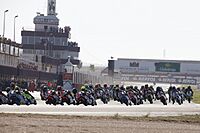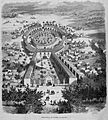Albacete facts for kids
Quick facts for kids
Albacete
|
|||
|---|---|---|---|
|
|
|||
|
|||
| Nicknames:
New York of La Mancha, City of the Cutlery
|
|||
| Country | Spain | ||
| Autonomous community | Castilla–La Mancha | ||
| Province | Albacete | ||
| Government | |||
| • Type | ayuntamiento | ||
| • Body | Ayuntamiento de Albacete | ||
| Area | |||
| • Total | 1,125.91 km2 (434.72 sq mi) | ||
| Elevation | 686 m (2,251 ft) | ||
| Population
(2018)
|
|||
| • Total | 173,050 | ||
| • Density | 153.698/km2 (398.076/sq mi) | ||
| Demonyms | Albacetian, Albacetene albaceteño, -ña; albacetense (es) |
||
| Time zone | UTC+1 (CET) | ||
| • Summer (DST) | UTC+2 (CEST) | ||
| Postal code |
02XXX
|
||
| Area code(s) | +34 (ES) + 967 (AB) | ||
Albacete is a lively city and municipality in the Spanish region of Castilla–La Mancha. It is also the capital city of the province of Albacete.
The city is located in the southeast of Spain, in a flat area known as Los Llanos. It's about halfway between Madrid and the Mediterranean coast. Albacete has good connections by road, railway (including high-speed trains), and even an airport.
With over 174,000 people (in 2020), Albacete is the largest city in Castilla–La Mancha. Its municipality is also one of the biggest in Spain by land area, covering about 1,126 square kilometers.
The city's name comes from the Arabic word Al-Basīṭ, which means "The Flat." This name describes the flat land around the city. Albacete is famous for making knives and has a reputation for being one of the most accessible cities in Spain because of its flat landscape.
One of the most exciting events in Albacete is the September Feria de Albacete. This fair is so important that it's recognized as a festival of "International Tourist Interest."
Albacete is also a center for business and learning. It has several large industrial zones and is home to a campus of the University of Castilla–La Mancha. The aviation industry is a big part of the city's economy, with important military and pilot training facilities located here.
Contents
- What Does the Name Albacete Mean?
- A Look Back: The History of Albacete
- Where is Albacete Located?
- How Many People Live in Albacete?
- What is Albacete's Economy Like?
- Learning in Albacete: Education
- Military and Defense in Albacete
- What to See and Do in Albacete
- Green Spaces: Parks and Gardens
- Culture and Art in Albacete
- Symbols of Albacete
- Getting Around: Transport in Albacete
- Sports in Albacete
- Albacete's International Friends
- Images for kids
- See also
What Does the Name Albacete Mean?
The name Albacete comes from the old Arabic name for the area, Al-Basīṭ. This Arabic word means "the plain" or "the flat land." It perfectly describes the flat geography of the region where the city is built.
The people who live in Albacete are called albacetense or albaceteño/a.
A Look Back: The History of Albacete
The city of Albacete has a long and interesting history. It started as a small village during the time of Moorish rule in Spain. Its name, Al-Basīṭ, was given by the Moors because of the flat land.
In 1240, Albacete became part of the Christian kingdom of Castile under King Ferdinand III. Later, in 1375, Albacete gained its independence from a nearby town and became its own town. This was a big step for the city!
About a century later, in 1476, the Catholic Monarchs (King Ferdinand and Queen Isabella) gave Albacete permission to hold a weekly market. This helped the town grow and become an important trading center.
During the 16th century, Albacete supported Emperor Charles V. This was a time when the church of San Juan Bautista, which later became a cathedral, began to be built.
Albacete's location between Madrid and Spain's east coast, along with its rich farmland, helped it grow even more. In 1710, King Philip V allowed Albacete to hold an annual fair. This fair became very popular and is still a major event today.
In 1833, Albacete was chosen as the capital of the new province of Albacete. This made it an even more important city. Soon after, in 1834, a regional court was set up in Albacete, covering several provinces.
The railway arrived in Albacete in 1855, connecting it to other major cities. In 1862, Queen Isabella II officially gave Albacete the title of "city." By 1888, Albacete was the first provincial capital in Spain to have electric street lighting!

Between 1900 and 1939, the city's population grew rapidly. Many important public works were built, like the water supply system and the Abelardo Sanchez Park.
During the Spanish Civil War (1936–1939), Albacete played a key role. Its airbase was a main headquarters for the Republican air force. It also served as the main base for the International Brigades, who were volunteers from other countries fighting for the Republican side. A monument now stands in the city to remember them.
In recent times, Albacete has continued to develop. In 1982, the High Court of Justice for Castilla–La Mancha was established here. The growth of the University of Castilla–La Mancha in 1985 also brought new energy and life to the city.
Where is Albacete Located?
Geography and Landscape
Albacete is in the southeast of Spain, on the flat plains of La Mancha. It sits at an elevation of about 686 meters (2,251 feet) above sea level.
The area around Albacete is very flat and open. Historically, parts of the municipality used to get flooded after heavy rains. To solve this, the Royal Canal of Albacete was built, which helped drain the water and improve the land.
What is the Climate Like?
Albacete has a cold semi-arid climate. This means it has cool winters and hot summers. Both seasons are usually dry. Because it's far from the sea, there are big temperature changes throughout the year.
Rainfall is low, mostly happening in spring and autumn. Sometimes, it even snows in winter!
| Climate data for Albacete Base Area 702 m (2,303 ft) (1981–2010) | |||||||||||||
|---|---|---|---|---|---|---|---|---|---|---|---|---|---|
| Month | Jan | Feb | Mar | Apr | May | Jun | Jul | Aug | Sep | Oct | Nov | Dec | Year |
| Record high °C (°F) | 22.8 (73.0) |
25.4 (77.7) |
30.0 (86.0) |
33.1 (91.6) |
36.7 (98.1) |
41.0 (105.8) |
42.9 (109.2) |
43.3 (109.9) |
39.0 (102.2) |
33.6 (92.5) |
29.0 (84.2) |
21.1 (70.0) |
43.3 (109.9) |
| Mean daily maximum °C (°F) | 10.5 (50.9) |
12.5 (54.5) |
16.3 (61.3) |
18.4 (65.1) |
22.8 (73.0) |
29.1 (84.4) |
33.2 (91.8) |
32.3 (90.1) |
27.0 (80.6) |
20.6 (69.1) |
14.5 (58.1) |
10.9 (51.6) |
20.7 (69.3) |
| Daily mean °C (°F) | 5.2 (41.4) |
6.8 (44.2) |
9.8 (49.6) |
11.9 (53.4) |
16.1 (61.0) |
21.4 (70.5) |
25.0 (77.0) |
24.6 (76.3) |
20.3 (68.5) |
14.8 (58.6) |
9.2 (48.6) |
6.0 (42.8) |
14.3 (57.7) |
| Mean daily minimum °C (°F) | −0.2 (31.6) |
1.0 (33.8) |
3.3 (37.9) |
5.4 (41.7) |
9.2 (48.6) |
13.8 (56.8) |
16.9 (62.4) |
16.8 (62.2) |
13.5 (56.3) |
8.9 (48.0) |
4.0 (39.2) |
1.2 (34.2) |
7.8 (46.0) |
| Record low °C (°F) | −24.0 (−11.2) |
−22.5 (−8.5) |
−10.4 (13.3) |
−5.4 (22.3) |
−1.0 (30.2) |
3.0 (37.4) |
7.5 (45.5) |
5.0 (41.0) |
1.0 (33.8) |
−6.3 (20.7) |
−8.4 (16.9) |
−18.8 (−1.8) |
−24.0 (−11.2) |
| Average precipitation mm (inches) | 20.6 (0.81) |
24.9 (0.98) |
26.7 (1.05) |
40.4 (1.59) |
43.4 (1.71) |
34.6 (1.36) |
9.3 (0.37) |
10.6 (0.42) |
33.7 (1.33) |
41.8 (1.65) |
34.4 (1.35) |
31.2 (1.23) |
352.6 (13.88) |
| Average precipitation days (≥ 1 mm) | 4.1 | 4.6 | 4.7 | 5.9 | 6.0 | 3.4 | 1.0 | 1.5 | 3.7 | 5.3 | 5.1 | 5.2 | 50.4 |
| Average snowy days | 0.9 | 1.4 | 0.6 | 0.2 | 0 | 0 | 0 | 0 | 0 | 0 | 0.4 | 0.6 | 4.1 |
| Average relative humidity (%) | 77 | 71 | 63 | 60 | 55 | 49 | 44 | 49 | 59 | 70 | 76 | 80 | 63 |
| Mean monthly sunshine hours | 153 | 165 | 217 | 241 | 271 | 318 | 358 | 324 | 253 | 201 | 152 | 134 | 2,787 |
| Source: Agencia Estatal de Meteorologia | |||||||||||||
How Many People Live in Albacete?
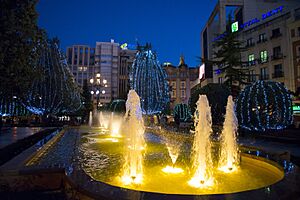
As of January 1, 2019, Albacete had 173,329 residents. This makes it the most populated city in the region of Castilla–La Mancha. It's also one of the most populated inland cities in Spain.
The city has grown a lot over the years. Between 1970 and 2005, its population increased by 71%!
Many people from other countries also live in Albacete. In 2014, about 6.3% of the population were foreign nationals. They come from all over the world, with many from Romania, Bolivia, Morocco, and Colombia.
Besides the main city, the municipality of Albacete includes a smaller town called Aguas Nuevas and sixteen rural areas.
Albacete is also the center of a growing metropolitan area. This area includes Albacete and fourteen nearby towns, with a total population of over 219,000 people. Experts believe this area will continue to grow significantly in the coming years.
The people from Albacete are called albacetense or albaceteño/a.
What is Albacete's Economy Like?

Albacete is the most important economic center in Castilla–La Mancha. Its economy mainly relies on trade and services. It's a key shopping area for over half a million people from many towns in different provinces.
The city has large industrial zones, like Campollano and Romica. There are also special parks for the automotive, aeronautics, and technology industries.
Trade is very important in Albacete. The city has been a business hub since the 14th century, partly thanks to its agricultural fair. Its good location and transport links, along with the hardworking spirit of its people, have boosted its commercial strength. Albacete also hosts many trade fairs and has a modern Congress Hall.
Learning in Albacete: Education
Albacete is home to three universities, offering a total of 41 different degrees:
- University of Castilla–La Mancha
- National University of Distance Education
- Ecclesiastical San Damaso University
The city also has the Superior Conservatory of Music of Castilla–La Mancha, where students can study music at university level.
Military and Defense in Albacete
Albacete is very important for military and defense operations. It hosts several key national and international facilities:
NATO Pilot School (TLP)
The TLP is an international training center for pilots and air crews. Its goal is to make the air forces of NATO countries more effective. Pilots practice day and night flights and learn about air strategies. Many people from member countries work here, and thousands of troops visit each year for training.
Los Llanos Air Base
Los Llanos Air Base is one of Spain's main air bases. It's home to the 14th Wing and some of the most advanced aircraft of the Spanish Air Force, like the Eurofighter Typhoon. Over 1,000 people work at this base.
Wing 14
Wing 14 is a military unit of the Air Force of Spain. It uses powerful combat aircraft like the Eurofighter Typhoon for air missions. It has two squadrons: 141 Squadron and 142 Squadron.
Air Maestranza Albacete
Albacete's Air Arsenal is the most important in Spain. Its job is to maintain and repair Air Force aircraft at the highest level. It covers a huge area of over 470,000 square meters and employs more than 600 workers.
What to See and Do in Albacete
Buildings and Architecture
Old and New Buildings
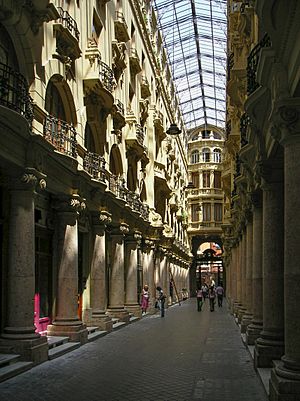
Albacete has many interesting buildings, especially from the late 19th and early 20th centuries. The city grew a lot when it became a provincial capital and when the railway arrived.
Some older important buildings include the Posada del Rosario (from the 16th century), which mixes Gothic, Mudejar, and Renaissance styles. Today, it's a tourism office and university library. The fairgrounds, opened in 1783, are also unique as Albacete is the only city in Spain with a special exhibition area just for its fair.
In the 19th century, buildings like the Palace of the Provincial Council and the Circus Theatre (1887) were built. The Circus Theatre is special because it can be used for both theater and circus shows.
In the early 20th century, wealthy families built beautiful Modernist buildings in the city center. Examples include the Casa del Hortelano (1912), which now houses the Museum of Cutlery, and the old City Hall (1902), now the Municipal Museum.
One of the most famous buildings from this time is the Gabriel Lodares Passage (1925). This is a shopping arcade that connects two streets, and it's one of only two such galleries left in Spain.
Newer buildings from the 21st century include the El Corte Inglés department store, the Albacete-Los Llanos train station, and the Congress Palace.
Churches and Religious Sites
Albacete has many churches and religious buildings in different styles. Some examples include the Church of Our Lady of Pilar, the Church of Fatima, and the Cathedral San Juan. You can also find the Monastery of the Incarnation and the Chapel of the Virgen de Los Llanos.
Famous Landmarks
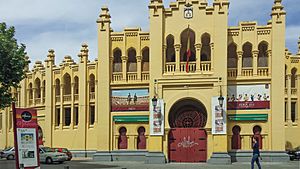
Many of Albacete's famous sights are in the city center. The Altozano Square is a main hub, with attractions like the Municipal Museum, the Grand Hotel, and the Justice Palace.
From Altozano Square, you can walk down Marqués de Molins and Tesifonte Gallego streets, also known as Broad Street. Here you'll find many impressive buildings like the Casino Primitivo and the Legorburo Building. Broad Street also connects to other important streets, including Conception Street, known for its nightlife, and Main Street, a busy shopping area.
The Lodares Passage and the Posada del Rosario are also nearby.
At the end of Broad Street is Gabriel Lodares Square, close to the Abelardo Sanchez Park. This park is the largest urban park in Castilla–La Mancha and is often called the "lung" of the city. Inside and around the park, you'll find the Archaeological Museum of Albacete and other fun places.
Other landmarks include the Cathedral of Albacete, the Town Hall, the Museum of Cutlery, and the famous Albacete Fairgrounds with its Iron Gate.
Green Spaces: Parks and Gardens
Albacete is known for its many green spaces. In 2010, the city had over 1.3 million square meters of green areas, which means about 7.3 square meters per person!
Some of the most important parks are:
- The Abelardo Sanchez Park: This is the biggest urban park in Castilla–La Mancha, covering 120,000 square meters in the city center.
- The Park Tree Festival: Home to the famous Water Reservoir Tree Festival, a symbol of the city.
- The Linear Park: A long promenade that stretches over 3 kilometers through the city, built along an old railway line.
- The Park Jardinillos: One of the oldest parks, located near the fairgrounds.
- The Botanical Garden of Castilla–La Mancha: A living museum with 7 hectares of land, featuring over 1,500 different plant species.
- The suburban park La Pulgosa: The largest green area in the city, covering almost 400,000 square meters, with playgrounds and sports facilities.
Albacete also has a great network of trails and natural areas, including the Maria Cristina Canal path, which is almost 48 kilometers long.
Culture and Art in Albacete
Museums and Galleries
Albacete has many museums and art spaces to explore:
- The Archaeological Museum of Albacete: Located in Abelardo Sanchez Park, it displays ancient artifacts from the region, from the Stone Age to the Middle Ages.
- The Pedagogical Museum and Children of Castilla–La Mancha: This unique museum shows the history of education and childhood in the region.
- The Municipal Museum of Albacete: Housed in the old City Hall, it features temporary art exhibitions and displays about the city's history.
- The Museum of Cutlery Albacete: Found in the Casa del Hortelano, it has a large collection of traditional Albacete knives and cutlery from around the world. It's one of only three cutlery museums in Europe!
- The Interpretation Center of Peace (Peace Museum): Located in old Civil War bomb shelters, it teaches about peace.
- The Botanical Garden of Castilla–La Mancha: A living museum of plants, with over 1,500 species.
The city also has many exhibition halls and cultural centers, like the Cultural Center Eixample, which host various cultural events.
Theatres and Performance Venues
Albacete offers several places to enjoy shows and performances:
- The Albacete Circus Theater: Opened in 1887, this special theater can be used for both plays and circus acts. It's one of only six such theaters from the 19th century still existing in the world.
- The Teatro de la Paz: A theater with 645 seats, offering a variety of shows throughout the year.
- The Auditorium Albacete: A venue for music concerts, dance performances, and plays.
- The Albacete Congress Palace: Opened in 2007, it can hold about 2,000 people and hosts all kinds of events.
Fun Festivities and Celebrations
The Albacete Fair
The Fair Albacete is the city's "biggest party," held from September 7th to 17th. It celebrates the city's patron saint, the Virgin of Los Llanos. It's also famous for its important bullfighting events.
The fair begins with a lively parade of floats, leading to the opening of the fairgrounds. For ten days, the city is filled with fun activities, cultural events, and sports, especially around the fairgrounds, which are packed with attractions and booths.
San Juan Festival
Around June 24th, Albacete celebrates the feast of John the Baptist, the city's patron saint. There are many cultural, sports, and leisure activities.
The main event is on the night of June 23rd, Midsummer. A torchlight parade leads to a huge bonfire, where old items are burned. This is followed by a big fireworks display and a festival. On June 24th, a pilgrimage takes place, moving the image of San Juan from the cathedral to the Park Tree Festival.
Easter Celebrations
During Holy Week (the week before Easter), different religious groups hold processions through the city. They carry religious statues and are accompanied by bugles and drums.
Albacete's Easter celebrations have become very well-known and are considered a "Regional Tourist Interest" event.
Carnival Fun
The weekend before Ash Wednesday, Albacete celebrates Carnival with costume parades and funny contests.
On Ash Wednesday, there's a unique tradition called the Burial of the Sardine. A sardine-shaped float is carried through the streets, then "tried," "convicted," and burned.
Other Special Days
- Christmas: Albacete lights up with decorations. On January 5th, the Three Kings arrive in a grand parade, giving out gifts.
- San Antón: On January 17th, animals are blessed by the bishop at the Asylum of San Anton. People often buy dates and churros.
- Mayos: On the night of April 30th to May 1st, people sing traditional songs called Mayos in Plaza Virgen de Los Llanos.
- Halloween: On October 31st, Halloween is celebrated with costume parties and carved pumpkins.
- Neighborhood Parties: Many neighborhoods in the city also hold their own lively parties throughout the year.
Bullfighting Tradition

Bullfighting is a strong tradition in Albacete. The province has many important bull farms.
The city has a bullfighting school that trains future bullfighters. The Albacete Bullring is very important, even though it's a "second category" bullring, it hosts many events. It can hold 12,000 spectators. During the "Bullfighting Albacete" fair in September, top bullfighters come to perform.
Famous bullfighters like Dámaso González and Manuel Caballero were born in Albacete.
Local Crafts: Knives and Cutlery
Albacete is famous for its knives and cutlery, a tradition that goes back to the 15th century. Albacete knives often have a special spring mechanism. Over time, this craft has grown to include scissors, daggers, and even surgical scalpels.
Today, the knife industry is modern, with factories in the city's industrial areas. There's a saying in Albacete: "the knife from Albacete is not given away, it's sold to a friend at a symbolic price, so it doesn't cut friendship." You can learn more about this history at the Museum of Cutlery. The city also hosts annual craft fairs for cutlery.
Delicious Local Food
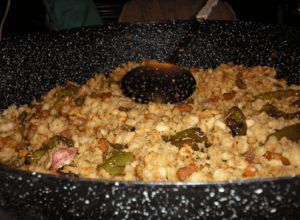
Albacete's food is a mix of traditional Spanish, Levantine (eastern coast), and La Mancha influences. It's rich and diverse.
Some popular dishes include:
- Gazpachos Manchegos: A hearty stew with game meat.
- Migas ruleras: Breadcrumbs cooked with ingredients like bacon.
- Pastor porridge: A dish made with flour, fresh bacon, and pebbles.
- Manchego ratatouille or wet: A summer dish with tomatoes and peppers.
- Atascaburras: A warming dish made with egg, oil, and cod, perfect for cold winters.
Albacete cuisine uses excellent local ingredients like manchego lamb (which has a special protected status) and manchego cheese (also protected). Local wines from the La Mancha, Almansa, and Manchela regions are also important.
For desserts, try the miguelitos from La Roda, or flowers and chips made with flour, eggs, and honey.
Symbols of Albacete
The City's Shield
The shield of Albacete has three towers on a silver background. These towers are made of stone and have black outlines. Above them is a black bat with its wings spread. The shield is topped with a Marquis crown, which is gold with jewels and pearls.
The City's Flag
The flag of Albacete is crimson red. In the center, it features the city's shield. The flag's dimensions are 90 cm high by 155 cm wide.
The City's Anthem
Albacete has its own anthem, which was first performed on September 8, 1926, during the Virgin of Los Llanos festival. It was re-released in 1975 and has become a special symbol of the city.
Getting Around: Transport in Albacete
Albacete is a major transport hub in southeast Spain. Its location makes it easy to travel to Madrid, Valencia, Alicante, Toledo, Ciudad Real, and Murcia by motorway.
City Buses
The city has 10 urban bus lines, with 7 running daily. The buses are red and white. They usually arrive every 11 minutes on most lines during the day. The wider municipality also has regular bus lines connecting the city to smaller towns.
Intercity Buses
The Albacete Bus Station is located in the northwest of the city. From here, you can take buses to major cities like Valencia, Murcia, Madrid, and many others across Spain.
Trains
The Albacete-Los Llanos railway station opened in 2010. It's a modern station with shops and entertainment. From here, you can travel by train to many places within the province, region, and across Spain.
Air Travel
The Albacete Airport (ABC/LEAB) is about 3.9 kilometers (2.4 miles) south of the city. It's very close to the Los Llanos Air Base and other aviation facilities.
Biking Around
Albacete is a great city for cyclists! It has over 42 kilometers (26 miles) of dedicated bike paths within the city. Adding to this, there are over 120 kilometers (75 miles) of greenways and groomed trails for biking.
Sports in Albacete
Football is very popular in Albacete. The city's main football club is Albacete Balompié, which has played in Spain's top league, La Liga. The women's team, Fundación Albacete, also plays in the Primera Division.
Albacete is home to the Circuito de Albacete, a race track that hosts important national and international motorsport events. Famous drivers like Michael Schumacher, Sebastian Vettel, Fernando Alonso, and motorcycle legends like Valentino Rossi and Marc Marquez have all raced here.
The Estadio Carlos Belmonte has hosted five matches for the Spanish national football team. Albacete has also been a host city for the Davis Cup in tennis. The Tour of Spain cycling race has started or finished in Albacete 42 times!
Another popular event is the International Half Marathon City of Albacete, held every May. On December 31st, many people dress up and run in the traditional San Silvestre race to end the year.
The city also has other great sports facilities, including the Albacete Tennis Club and the Las Pinaillas Golf Club, which was designed by the famous golfer Severiano Ballesteros.
Albacete's International Friends
Sister Cities
Albacete has special "sister city" agreements with several cities around the world. These agreements help promote cultural exchange and friendship:
- San Carlos, Nicaragua (1992)
- Dahira Bir Ganduz Sahrawi refugee camp, Algeria (1994)
- Vienne, France (1995)
- Reconquista, Argentina (1997)
- La Lisa, Cuba (2002)
- Houndé, Burkina Faso (2008)
- Nanchang, China (2012)
- Udine, Italy
Images for kids
-
The Fair of Albacete in the mid-19th century.
See also
 In Spanish: Albacete para niños
In Spanish: Albacete para niños



